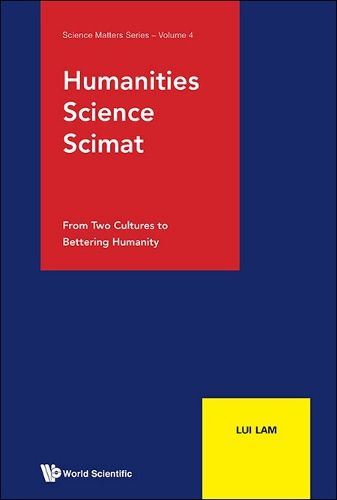Readings Newsletter
Become a Readings Member to make your shopping experience even easier.
Sign in or sign up for free!
You’re not far away from qualifying for FREE standard shipping within Australia
You’ve qualified for FREE standard shipping within Australia
The cart is loading…






This title is printed to order. This book may have been self-published. If so, we cannot guarantee the quality of the content. In the main most books will have gone through the editing process however some may not. We therefore suggest that you be aware of this before ordering this book. If in doubt check either the author or publisher’s details as we are unable to accept any returns unless they are faulty. Please contact us if you have any questions.
The humanities (and social science) are the disciplines that study human, which are essential in helping us to understand ourselves and others and the world around us. Since science is the study of everything in the universe and human is a material system consisting of the same atoms that make up other nonhuman systems, humanities are part of science. Thus, understanding correctly what science is about will be helpful in making progress in the humanities. To patch up the gap between the 'two cultures' derived from these two branches of knowledge, the best way is to recognize their common root in science and work through humanities-science synthesis, as advocated by Scimat, the new multidiscipline proposed by the author in 2007. Furthermore, raising the scientific level of the humanities, which include decision making, will help to make the world better.Humanities, Science, Scimat details these issues, consisting of three parts. Part I is about Scimat and the new humanities (history, philosophy, art). Part II is on the origin and nature of science, new insights on the life and works of selected scientists, some thoughts on science communication/popularization, and case examples of science innovation - all from the Scimat perspective. While Parts I and II are short essays with no references (with rare exceptions), Part III are longer articles with full references that supplement Parts I and II. Each essay/article starts with a color picture. They are all easy to read - nothing technical.In short, this book contains the basic knowledge about the humanities and science that everyone should know. The aimed readership is anyone, from high school students and laypeople to the professors, who are interested in what the humanities and science are about, and how we can work together to achieve a better humanity.
$9.00 standard shipping within Australia
FREE standard shipping within Australia for orders over $100.00
Express & International shipping calculated at checkout
This title is printed to order. This book may have been self-published. If so, we cannot guarantee the quality of the content. In the main most books will have gone through the editing process however some may not. We therefore suggest that you be aware of this before ordering this book. If in doubt check either the author or publisher’s details as we are unable to accept any returns unless they are faulty. Please contact us if you have any questions.
The humanities (and social science) are the disciplines that study human, which are essential in helping us to understand ourselves and others and the world around us. Since science is the study of everything in the universe and human is a material system consisting of the same atoms that make up other nonhuman systems, humanities are part of science. Thus, understanding correctly what science is about will be helpful in making progress in the humanities. To patch up the gap between the 'two cultures' derived from these two branches of knowledge, the best way is to recognize their common root in science and work through humanities-science synthesis, as advocated by Scimat, the new multidiscipline proposed by the author in 2007. Furthermore, raising the scientific level of the humanities, which include decision making, will help to make the world better.Humanities, Science, Scimat details these issues, consisting of three parts. Part I is about Scimat and the new humanities (history, philosophy, art). Part II is on the origin and nature of science, new insights on the life and works of selected scientists, some thoughts on science communication/popularization, and case examples of science innovation - all from the Scimat perspective. While Parts I and II are short essays with no references (with rare exceptions), Part III are longer articles with full references that supplement Parts I and II. Each essay/article starts with a color picture. They are all easy to read - nothing technical.In short, this book contains the basic knowledge about the humanities and science that everyone should know. The aimed readership is anyone, from high school students and laypeople to the professors, who are interested in what the humanities and science are about, and how we can work together to achieve a better humanity.